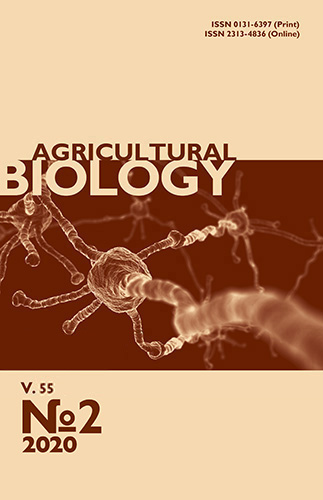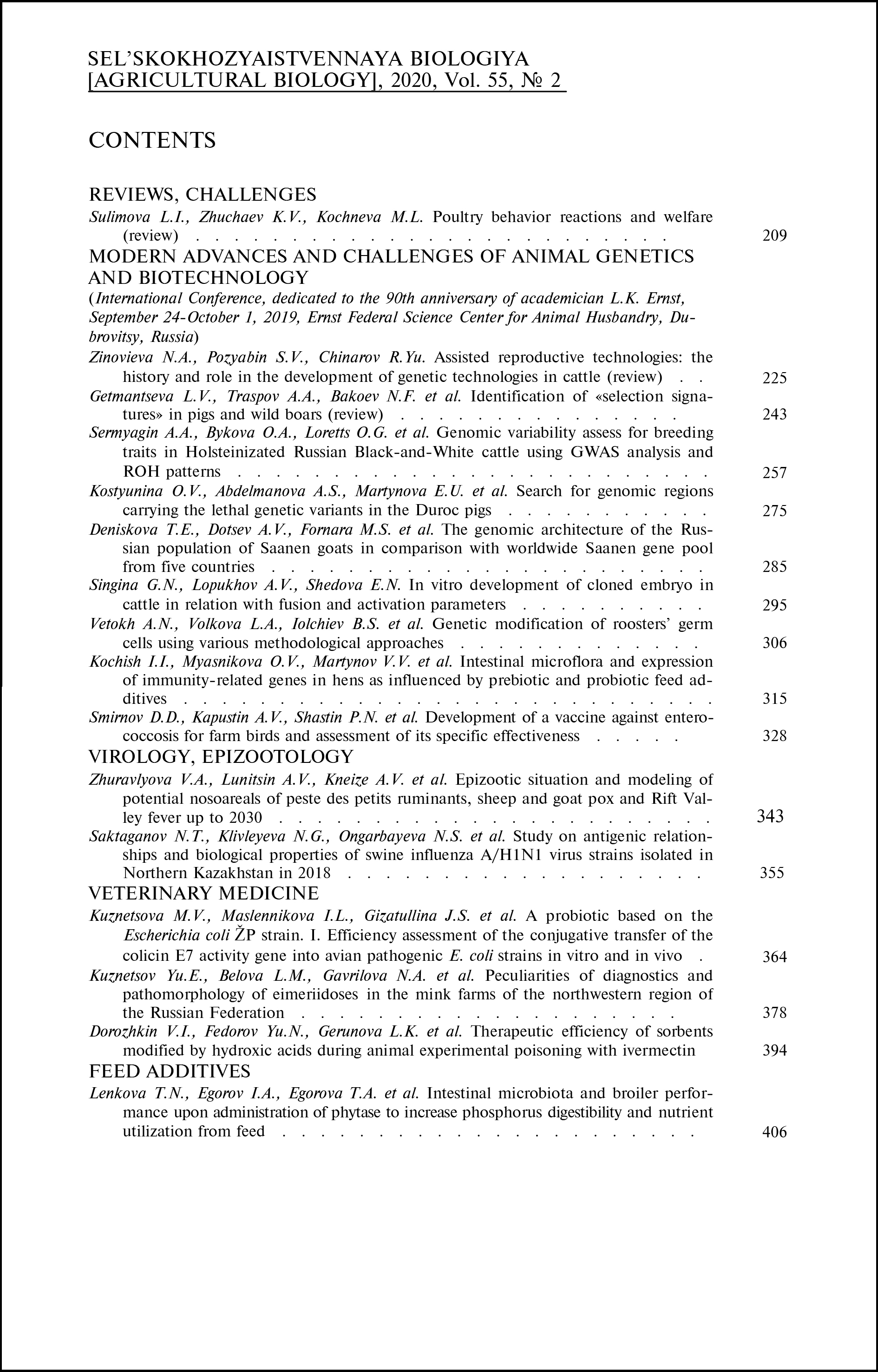doi: 10.15389/agrobiology.2020.2.275eng
UDC: 636.4:636.082:575.22:577.21
The equipment of the Center for Biological Resources and Bioengineering of Farm Animals (Ernst Federal Science Center for Animal Husbandry) was used for the study. Supported financially within the frame of GZ 0445-2019-0026, No. АААА-А18-118021590138-1
SEARCH FOR GENOMIC REGIONS CARRYING THE LETHAL GENETIC VARIANTS IN THE DUROC PIGS
O.V. Kostyunina1, A.S. Abdelmanova1, E.U. Martynova2, N.A. Zinovieva1
1Ernst Federal Science Center for Animal Husbandry,60, pos. Dubrovitsy, Podolsk District, Moscow Province, 142132 Russia, e-mail kostolan@mail.ru (✉ corresponding author), preevetic@mail.ru, n_zinovieva@mail.ru;
2Center of Life Sciences, Skolkovo Institute of Science and Technology, 3, ul. Nobelya, Moscow, 143026 Russia, e-mail elenamartynovaster@gmail.com
ORCID:
Kostyunina O.V. orcid.org/0000-0001-8206-3221
Martynova E.U. orcid.org/0000-0003-0802-0236
Abdelmanova A.S. orcid.org/0000-0003-4752-0727
Zinovieva N.A. orcid.org/0000-0003-4017-6863
Received October 31, 2019
The necessity to address the problem of reducing embryonic losses, which in pigs are estimated at the level up to 30 %, is not in doubt. LoF (Loss of Function) mutations, which in the homozygous state can lead to the termination of synthesis or synthesis of non-functional proteins, are considered as one of the genetic factors that cause embryonic mortality. While in cattle, an intensive search for LoF mutations is carried out, in pigs, studies of such mutations are still performed on a smaller scale. Whole-genome analysis using medium- and high-density SNP chips which are uniformly covering the entire genome allows researchers to apply new approaches to identify positional candidates for lethal recessive variants. One of such approaches is the analysis of the level of the linkage disequilibrium (LD) of alleles of SNP markers. The aim of our research was to search for genomic regions that carry presumed lethal recessive variants in Duroc pigs, based on the analysis of the linkage disequilibrium of alleles in SNP loci. Studies were carried out with 715 Duroc boars bred in JSC Top Gen (Voronezh region) in 2017-2019. Whole-genome genotyping was carried out using Porcine GGP HD DNA chips (Neogene/Illumina Inc., USA) containing about 70 thousand SNP. After the quality control, 42981 polymorphic SNP were selected for analysis. Search of reference sequences (rs) and clarification of their localization was carried out using the Ensembl database (http://www.ensembl.org). Functional gene annotations were performed using the GeneCards database (http://www.genecards.org/). Analysis of the maintenance of genetic equilibrium showed the presence of 990 SNPs with the absence of one of the homozygous genotypes (2.30 % of the total number of polymorphic SNPs), which were distributed among all pig chromosomes, including 205 SNPs, which were in the linkage disequilibrium (0.48 %). Chromosomes SSC9 (0.8 %), SSC5 (0.77 %), SSC7 (0.68 %) and SSC2 (0.68 %) were characterized by the highest ratio of SNPs in linkage disequilibrium, while chromosomes SSC13 (0.28 %), SSC4 (0.29 %) and SSC10 (0.30 %) were the lowest. For 52 SNPs, of which 25 SNPs were localized within genes, differences in observed and expected heterozygosity frequencies were statistically significant (p < 0.01). Among SNPs located in intergenic regions, two SNPs (rs81350198 and rs81337222) are associated with important phenotypes from earlier GWAS studies. For 12 of the 25 identified positional candidate genes (OR4C45, EPHB4, EML4, SLC4A1AP, ZFAT, CELSR2, NEGR1, LRRC32, MYOCD, HUNK, RPH3A,and DOCK1), we obtained the information on their role in various processes in organisms of mammals, including nervous system development, angiogenesis, cardiogenesis, cell differentiation, apoptosis and many others. The integration of DNA markers associated with lethal phenotypes into breeding programs, in addition to DNA markers identified by GWAS studies, will significantly improve the efficiency of marker and genomic breeding programs in pigs.
Keywords: pigs, linkage disequilibrium, lethal variants, LoF (loss of function), single nucleotide polymorphisms.
REFERENCES
- Pope W.F. Embryonic mortality in swine. In: Embryonic mortality in domestic species. M.T. Zavy, R.D. Geisert (eds.). CRC Press, Boca Raton, 1994: 53-77.
- Bickhart D.M., Hou Y., Schroeder S.G., Alkan C., Cardone M.F., Matukumalli L.K., Song J., Schnabel R.D., Ventura M., Taylor J.F., Garcia J.F., Van Tassell C.P., Sonstegard T.S., Eichler E.E., Liu G.E. Copy number variation of individual cattle genomes using next-generation sequencing. Genome Res., 2012, 22(4): 778-790 CrossRef
- Zinov'eva N.A. Haplotypes affecting fertility in Holstein cattle. Sel'skokhozyaistvennaya biologiya [Agricultural Biology], 2016, 51(4): 423-435 CrossRef
- Gorbach D., Mote B., Totir L., Fernando R., Rothschild M. Polydactyl inheritance in the pig. Journal of Heredity, 2010, 101(4): 469-475 CrossRef
- Howard D.M., Pong-Wong R., Knap P.W., Woolliams J.A. Use of haplotypes to identify regions harbouring lethal recessive variants in pigs. Genetics Selection Evolution, 2017, 49: 57 CrossRef
- Häggman J., Uimari P. Novel harmful recessive haplotypes for reproductive traits in pigs. J. Anim. Breed. Genet., 2017, 134(2): 129-135 CrossRef
- Derks M.F.L., Gjuvsland A.B., Bosse M., Lopes M.S., van Son M., Harlizius B., Tan B.F., Hamland H., Grindflek E., Groenen M.A.M., Megens H.-J. Loss of function mutations in essential genes cause embryonic lethality in pigs. PLoS Genet., 2019, 15(3): e1008055 CrossRef
- Purcell S., Neale B., Todd-Brown K., Thomas L., Ferreira M.A.R., Bender D., Maller J., Sklar P., de Bakker P.I.W., Daly M.J., Sham P.C. PLINK: A tool set for whole-genome association and population-based linkage analyses. The American Journal of Human Genetics, 2007, 81(3): 559-575 CrossRef
- Drag M., Hansen M.B., Kadarmideen H.N. Systems genomics study reveals expression quantitative trait loci, regulator genes and pathways associated with boar taint in pigs. PLoS ONE, 2018, 13(2): e0192673 CrossRef
- Fernandes L.T., Ono R.K., Ibelli A.M.G., Lagos E.B., Morés M.A.Z., Cantão M.E., Lorenzetti W.R., Peixoto J. de O., Pedrosa V.B., Ledur M.C. Novel putative candidate genes associated with umbilical hernia in pigs. Proc. World Congress on Genetics Applied to Livestock Production. Electronic Poster Session. Species. Porcine 2. Auckland, New Zealand, 2018: 743.
- Long Y., Su Y., Ai H., Zhang Z., Yang B., Ruan G., Xiao S., Liao X., Ren J., Huang L., Ding N. A genome-wide association study of copy number variations with umbilical hernia in swine. Anim. Genet., 2016, 47(3): 298-305 CrossRef
- Borisevich D.I., Shatalova L.V., Korostin D.O., Il'inskii V.V. Vestnik Rossiiskogo gosudarstvennogo meditsinskogo universiteta,2016, 1: 20-24 (in Russ.).
- Braun T., Voland P., Kunz L., Prinz C., Gratzl M. Enterochromaffin cells of the human gut: sensors for spices and odorants. Gastroenterology, 2007, 132(5): 1890-1901 CrossRef
- Kaji I., Karaki S., Kuwahara A. Effects of luminal thymol on epithelial transport in human and rat colon. American Journal of Physiology-Gastrointestinal and Liver Physiology, 2011, 300(6): G1132-G1143 CrossRef
- Becerikli M., Merwart B., Lam M.C., Suppelna P., Rittig A., Mirmohammedsadegh A., Stricker I., Theiss C., Singer B.B., Jacobsen F., Steinstraesser L. EPHB4 tyrosine-kinase receptor expression and biological significance in soft tissue sarcoma. Int. J. Cancer., 2015, 136(8): 1781-1791 CrossRef
- Gerety S.S., Wang H.U., Chen Z.F., Anderson D.J. Symmetrical mutant phenotypes of the receptor EphB4 and its specific transmembrane ligand ephrin-B2 in cardiovascular development. Molecular Cell, 1999, 4(3): 403-414 CrossRef
- Fry A.M., O'Regan L., Montgomery J., Adib R., Bayliss R. EML proteins in microtubule regulation and human disease. Biochemical Society Transactions,2016, 44(5): 1281-1288 CrossRef
- Xu Q., Deller M.C., Nielsen T.K., Grant J.C., Lesley S.A., Elsliger M.A., Deacon A.M., Wilson I.A. Structural insights into the recognition of phosphopeptide by the FHA domain of kanadaptin. PLoS ONE, 2014, 9(9): e107309 CrossRef
- Tsunoda T., Doi K., Ishikura S., Luo H., Nishi K., Matsuzaki H., Koyanagi M., Tanaka Y., Okamura T., Shirasawa S. Zfat expression in ZsGreen reporter gene knock in mice: Implications for a novel function of Zfat in definitive erythropoiesis. International Journal of Molecular Medicine,2018, 42(5): 2595-2603 CrossRef
- Tsunoda T., Takashima Y., Tanaka Y., Fujimoto T., Doi K., Hirose Y., Koyanagi M., Yoshida Y., Okamura T., Kuroki M., Sasazuki T., Shirasawa S. Immune-related zinc finger gene ZFAT is an essential transcriptional regulator for hematopoietic differentiation in blood islands. Proceedings of the National Academy of Sciences, 2010, 107(32): 14199-14204 CrossRef
- Ji H.Y., Yang B., Zhang Z.Y., Ouyang J., Yang M., Zhang X.F., Zhang W.C., Su Y., Zhao K.W., Xiao S.J., Yan X.M., Ren J., Huang L.S. A genome-wide association analysis for susceptibility of pigs to enterotoxigenic Escherichia coli F41. Animal,2016, 10(10): 1602-1608 CrossRef
- Tissir F., Qu Y., Montcouquiol M., Zhou L., Komatsu K., Shi D., Fujimori T., Labeau J., Tyteca D., Courtoy P., Poumay Y., Uemura T., Goffinet A.M. Lack of cadherins Celsr2 and Celsr3 impairs ependymal ciliogenesis, leading to fatal hydrocephalus. Nat. Neurosci., 2010, 13: 700-707 CrossRef
- Schäfer M., Bräuer A.U., Savaskan N.E., Rathjen F.G., Brümmendorf T. Neurotractin/kilon promotes neurite outgrowth and is expressed on reactive astrocytes after entorhinal cortex lesion. Molecular and Cellular Neuroscience, 2005, 29(4): 580-590 CrossRef
- Lee K.-T., Byun M.-J., Kang K.-S., Park E.-W., Lee S.-H., Cho S., Kim H.Y., Kim K.-W., Lee T.H., Park J.-E., Park W.C., Shin D.H., Park H.-S., Jeon J.-T., Choi B.-H., Jang G.-W., Choi S.-H., Kim D.-W., Lim D., Park H.-S., Park M.-R., Ott J., Schook L. B., Kim T.-H., Kim H. Neuronal genes for subcutaneous fat thickness in human and pig are identified by local genomic sequencing and combined SNP association study. PLoS ONE, 2011, 6(2): e16356 CrossRef
- Stockis J., Colau D., Coulie P.G., Lucas S. Membrane protein GARP is a receptor for latent TGF-b on the surface of activated human Treg. Eur. J. Immunol., 2009, 39(12): 3315-3322 CrossRef
- Kosova G., Scott N.M., Niederberger C., Prins G.S., Ober C. Genome-wide association study identifies candidate genes for male fertility traits in humans. The American Journal of Human Genetics, 2012, 90(6): 950-961 CrossRef
- Hoofnagle M.H., Neppl R.L., Berzin E.L., Teg Pipes G.C., Olson E.N., Wamhoff B.W., Somlyo A.V., Owens G.K. Myocardin is differentially required for the development of smooth muscle cells and cardiomyocytes. American Journal of Physiology-Heart and Circulatory Physiology, 2011, 300(5): H1707-H1721 CrossRef
- Lin C.-C., Huang C.-C., Lin K.-H., Cheng K.-H., Yang D.-M., Tsai Y.-S., Ong R.-Y., Huang Y.N., Kao L-.S. Visualization of Rab3A dissociation during exocytosis: a study by total internal reflection microscopy. J. Cell. Physiol., 2007, 211(2): 316-326 CrossRef
- Laurin M., Fradet N., Blangy A., Hall A., Vuori K., Cóté J.-F. The atypical Rac activator Dock180 (Dock1) regulates myoblast fusion in vivo. Proceedings of the National Academy of Sciences, 2008, 105(40): 15446-15451 CrossRef
- Yang Y., Zhou R., Mu Y., Hou X., Tang Z., Li K. Genome-wide analysis of DNA methylation in obese, lean, and miniature pig breeds. Scientific Reports, 2016, 6: 30160 CrossRef
- Ponsuksili S., Zebunke M., Murani E., Trakooljul N., Krieter J., Puppe B., Schwerin M., Wimmers K. Integrated Genome-wide association and hypothalamus eQTL studies indicate a link between the circadian rhythm-related gene PER1 and coping behavior. Scientific Reports, 2015, 5: 16264 CrossRef
- Belous A.A., Sermyagin A.A., Kostyunina O.V., Brem G., Zinov'eva N.A. Study of genetic architecture of feed conversion rate in duroc young boars (Sus scrofa) based on the genome-wide SNP analysis. Sel'skokhozyaistvennaya biologiya [Agricultural Biology], 2019, 54(4): 705-712 CrossRef












